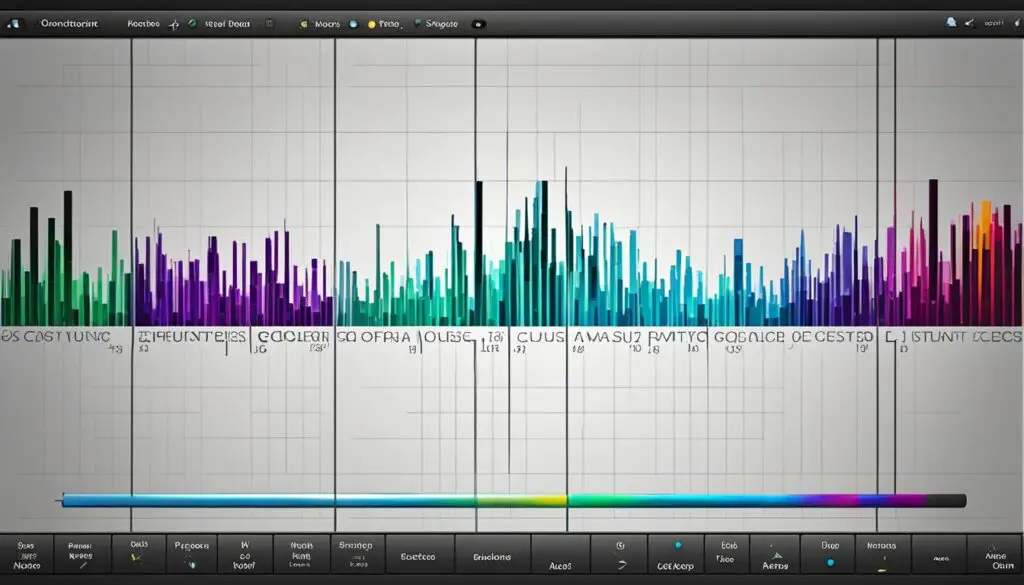How do you maintain the original vibe of the vocals in a mashup?
In the world of remixes, keeping the true feel of the original song is key. When you work with a cappella remixes or vocal stems, you aim to mix the vocals with the beat smoothly. This keeps the energy and personality of the original song.
Skilled producers use special tools and techniques to make sure the vocals stand out. They make sure the vocals sound as powerful as in the original song. Knowing how different music genres treat vocals helps you mix them well into a new song.
This guide will show you how to keep the original feel of the vocals in a mashup. You’ll learn expert strategies to make your vocal-centric remixes sound real and dynamic.
Preserving Vocal Clarity in a Mashup
In music production, vocals are the main focus. Everything else, like production and mix, supports them. Keeping vocals clear and present is key, especially in a vocals-over-beat mashup. Artists new to music might make songs too busy, making vocals hard to hear. To fix this, mute parts that clash with the vocals.
Using equalization (EQ) is a great way to keep vocals clear. You can use subtractive EQ to remove bad frequencies and additive EQ to shape the vocals. This helps the vocals stand out in the mix.
Equalization Techniques for Vocal Separation
For tonal shaping of vocals, mix subtractive and additive EQ. First, use a high-pass filter to cut low frequencies, up to 100 Hz, to remove unwanted noise. Then, target low-mid frequencies, around 150-250 Hz, to make room for the vocals.
To make vocals clearer and more present, boost high-mid frequencies like 1-2 kHz, 3 kHz, or 5 kHz. This improves how clear and distinct the vocals sound. A smart EQ plugin like MIXROOM can also help by suggesting frequency changes based on professional vocals.
It’s important to keep the vocal levels consistent. Use a LUFS meter to make sure they’re right, aiming for a reading of ±4LUFS. Techniques like compression and saturation can also help the vocals stand out.

By using these equalization techniques, you can separate the vocals from the beat. This keeps the vocals clear and distinct in the vocals-over-beat mashup. It helps keep the original vibe and clarity of the vocals, making the final product sound professional.
Dynamics Processing for Vocal Integration
Making a great vocals-over-beat mashup means paying close attention to the vocal’s dynamics. Using smart dynamics processing, you can make sure the vocals blend well with the beat. They won’t overpower it or get lost.
Volume automation is a key method. It lets you control the vocals’ levels perfectly throughout the song. By adjusting the volume manually, you keep the right balance between the vocals and the music. This makes the vocals sound natural and well-integrated.
Adding multi-stage compression can also improve the vocal dynamics. By using compressors with different settings, you can even out the volume while keeping the vocal’s natural feel. The first compressor tames loud parts, and the next ones make the levels more even.
Vocal leveling techniques also help keep the vocals at consistent levels. You might use expanders, limiters, or parallel compression for this. These tools help make the vocal track cohesive and balanced.
| Technique | Purpose | Example Settings |
|---|---|---|
| Volume Automation | Precise level control of vocals | Manual fader adjustments throughout the track |
| Multi-stage Compression | Smoothing out vocal dynamics |
|
| Vocal Leveling | Maintaining consistent vocal levels |
|
Using these techniques, you can make the vocals stand out in the mashup. They’ll be clear and strong, without overshadowing or getting lost in the mix.

Vocals-Over-Beat Mashup Techniques
In music production, creating vocals-over-beat mashups is now a favorite among DJs and producers. This method mixes the vocals of one song with the beats of another. It makes for a fresh and exciting sound. DJs and producers use special techniques to keep the vocals and beats together smoothly.
Getting high-quality acapella vocals is key to a great mashup. This needs special tools and skills to pull out the vocals from the original song. The goal is to keep the vocals’ original feel and power. Then, producers mix these vocals with the right beats.
Using parallel processing and creative effects is also vital. This lets producers control the vocals and beats separately. They can adjust the sound’s dynamics, frequency, and how they blend together. Tools like dynamic compression, equalization, and reverb help make the vocals and beat sound together perfectly.
Blending the vocals and beat well is crucial for a great mashup. By matching the rhythm and harmony of both, producers make the music flow smoothly. This focus on detail makes the music more engaging and sets the creator apart.
To make a hit vocals-over-beat mashup, you need to know a lot about music production. You also need a good sense of rhythm and harmony. And, you should be open to trying out new sounds and techniques. By doing this, DJs and producers can make unique mashups that grab listeners and show off their style.
Vocal Isolation and Stem Mastering
In the world of vocals-over-beat mashups, getting clear vocal stems is key. By taking high-quality vocal tracks from the original songs, producers can mix them with beats smoothly. This keeps the original feel and clarity of the performance. This part talks about how to get these vocal stems and master them for a professional sound in mashups.
Tools for Extracting Vocal Stems
New audio repair tools have changed how we get vocal stems. These tools use advanced algorithms and learning to split vocals from the music with great accuracy. Some top tools for this job are:
- Lalal.ai – This AI tool has learned from thousands of pro-mastered tracks for precise stem splitting with little noise.
- BandLab Splitter – A free tool that’s easy to use, letting producers upload and download stems without limits.
- SongDonkey AI – A paid service that separates stems for a song fee, giving high-quality 44.1kHz WAV files.
- Vocal Remover – A free tool that can be supported by donations, offering a budget-friendly way to isolate vocals.
These tools and services offer different features and prices to meet the needs and budgets of music makers and audio experts.
Stem Mastering Techniques
After getting the vocal stems, mastering them is the next step. This means using techniques like:
- Equalization – Adjusting the vocal’s frequencies so it fits well in the mix.
- Dynamic Processing – Using compression and expansion to control the vocal’s volume and make it stand out.
- Saturation and Shaping – Adding subtle distortion and shaping to give the vocals character and punch.
- Resonance and Sibilance Reduction – Fixing any bad resonances or sibilance that came up during stem extraction.
- Stereo Widening and Maximization – Using M/S processing and Air EQ to make the vocals wider and louder.
Mastering the vocal stems this way makes sure they blend well with the beat. This creates a smooth and polished mashup.
| Tool | Pricing | Key Features |
|---|---|---|
| Lalal.ai | Lite: $18 for 90 minutes Pro: $35 for 500 minutes Plus: $25 for 300 minutes | AI-powered stem splitting with high accuracy |
| BandLab Splitter | Free | Unlimited uploads and downloadable stems |
| SongDonkey AI | $0.50 per song | Master-quality 44.1kHz WAV output |
| Vocal Remover | Free with donation option | Straightforward and cost-effective solution |
Creative Applications of Vocal Mashups
Vocal mashups are changing the music scene. They blend different voices to create something new. This lets artists express themselves in unique ways.
A cappella remixes show how powerful the human voice can be. Artists take songs and focus on the vocals. Then, they mix these vocals in new ways to surprise listeners.
The vocals-over-beat mashup is another way to mix music. It puts new beats behind classic vocals. This makes old songs sound fresh and new.
Pentatonix’s version of “Get Lucky” by Daft Punk is a great example. They took the song’s famous vocals and made it their own. This shows off their amazing singing skills.
As more people enjoy vocal mashups, artists are getting creative. They mix different voices and create complex harmonies. This opens up endless possibilities in music.
Vocal mashups bring new life to old songs and create new sounds. They’re changing how we experience music. As remix culture grows, these vocal mixes will keep shaping music’s future.
Conclusion
Making a great vocals-over-beat mashup is all about finding the right balance. We’ve looked at many techniques and tips to help you get there. These methods are key to keeping the original feel of the vocals while blending them well with the music.
Using equalization and dynamics processing is crucial. Each step in the process helps keep the vocals sounding true to themselves. By shaping the vocal tones and controlling how clear they are, you can make the mashup more emotional and unique.
As you dive deeper into vocals-over-beat mashup, vocal processing, remix engineering, and audio production, don’t be afraid to try new things. The secret to making amazing mashups is to be creative and take risks. Keep exploring and find new ways to make the music come alive, leaving a memorable impact on your listeners.







